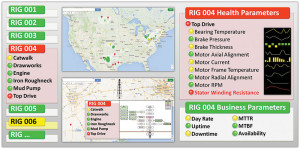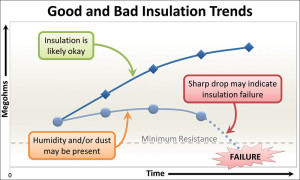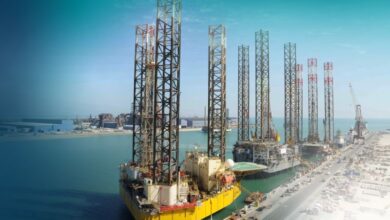Risk-informed decisions allow realization of rigs’ inherent reliability
Asset integrity dashboard can help turn real-time field data into intelligence to support management of critical drilling equipment
By Troy G. Schwartz, Life Cycle Engineering

Drilling rig operation, maintenance and management involves fast turnaround and high-pressure work with critical tasks. These tasks are performed by diversely skilled personnel on highly complex and specialized systems in variable weather conditions and geographically dispersed locations. Tie that together with massive amounts of inconsistent, often unusable or inaccessible data, and it is very easy for priorities to be misdirected and critical information to fall through the cracks. This can lead to a reactive culture rather than one where value-based, risk-informed decisions are made.
A key component of operational excellence is to establish a culture of continuous improvement and innovation, from roughnecks to the CEOs, that builds upon a strong foundation focused on asset integrity. Drilling operations and maintenance (O&M) departments have a direct influence on this culture. Using automated and manual logging methods, companies often collect and store information on hardware performance and drilling environments from rig sites. Although extremely valuable, this information has limited impact on equipment operations, maintenance programs and business decisions due to the lack of accessibility, lack of analyst expertise and limited communication to those who could use the data.
Inherent reliability
Once a rig has been commissioned and deployed, its reliability is essentially fixed from a design and engineering perspective. This is referred to as the inherent reliability of the rig, and it represents the maximum reliability performance expected of the rig based on the overall design and selection of equipment. In order to achieve this level of engineered robustness, rig operation and maintenance functions must be fully engaged to effectively manage the reliability and availability of the rig.
For critical assets where upfront expenses are a driver or where an asset cannot be made more reliable, one can choose to designate a part as “life limited.” Preventive maintenance plans can be developed for specified operation times and a number of cycles for repairs or replacements, rather than waiting for an untimely failure to occur or running to failure. Unplanned failures can lead to corrective maintenance actions that may result in downtime and potential higher costs due to delays in drilling or major incidents. It is important to understand the relationship between inherent reliability and the maintenance attributes of an asset. This directly affects performance, cost, schedule and overall life-cycle cost.
By combining reliability and maintainability factors, the availability of critical assets can be determined. Availability is the percentage of time that the asset is capable of performing its function (operating time plus standby time) divided by the total period, whether in service or not. In other words, availability is the probability that the asset has not failed or is undergoing a maintenance or repair function when it needs to be used. Availability is typically shown as a percentage of uptime and downtime. Common formulas are uptime/(uptime + downtime) x 100, or MTBF/(MTBF + MTTR) x 100, where MTBF is mean time between failure.
Therefore, a smoke detector that requires only 50 hours of preventive maintenance downtime each year has 99.4% availability for that year.
Performance standards for drilling equipment use these definitions to determine availability. The ultimate availability goal is to minimize failures, but it also involves minimizing the downtime needed to restore the system functionality either by leveraging redundancies, critical spares, repair or replacing failed items. For regulatory compliance, the availability of critical assets is evaluated against the proportion of time it is actually required to operate. Availability is strictly used as a measure of operational readiness of an item – will it work when needed.
Rig asset integrity dashboard
Due to the high intensity of drilling operations, rigs are seeing higher levels of stress that require additional assurances that the rigs are being adequately maintained and inspected. Most in-service mechanical equipment requires some form of periodic inspection and maintenance to monitor integrity and health condition in order to prolong the life cycle or to prevent catastrophic failures. Without adequate insight into the fundamental failure mechanisms of equipment, it becomes nearly impossible to accurately determine which tasks require the most scrutiny and when these actions should be performed.

Combining the results of a failure modes and effects analysis (FMEA) with real-time supporting field data provides the framework and early warning system for potential failures that may occur. This information aids the development of mitigation plans to reduce or eliminate the probable effect of each failure on other system components and overall operational success. By leveraging FMEA, criticality assignments and data collected using the guidelines in ISO 14224, “Petroleum, Petrochemical and Natural Gas Industries — Collection and Exchange of Reliability and Maintenance Data for Equipment,” reliability, maintainability and availability metrics can be developed. This initiates the transformation of raw data into process intelligence.
Once developed, this valuable process intelligence can be automated and communicated in a portable, accessible format. A well-designed automated diagnostic system, or “asset integrity dashboard,” allows operations personnel and technicians to make strategic decisions based on real-life experiences and actual supporting operational and cost data. This will help to effectively eliminate and manage existing problems.
The transparent dashboard is capable of monitoring drilling parameters, predicting critical asset failures and providing insight to overall rig healthg. Immediate feedback is provided to O&M personnel and management. The dashboard can determine equipment health by monitoring critical asset key failure modes. These are identified and triggered only when maintenance is necessary or the business value justifies increased priority.
With the capability to delineate rig and area performance, a top-level dashboard can increase visibility at various levels – geographic, rig, subsystem, asset, etc – to prioritize and tailor maintenance policies, minimize costs and human error, and recover lost revenue. Basic steps to create an asset integrity dashboard are:
1. Identify critical assets (top drive, drawworks, engines, etc);
2. Identify key O&M parameters of interest to monitor (asset attributes, etc);
3. Identify key business cost factors (uptime, rig dayrate, labor rates, etc);
4. Collect data (gather, assess data integrity, etc);
5. Analyze data (transform into viable intelligence);
6. Visualize and communicate (web-based interface); and
7. Refine and improve.
A dashboard should encompass a variety of capabilities to view key real-time data collected from sensing hardware all the way to graphical presentation of the asset condition with recommended maintenance actions within a given time frame. Additionally, a dashboard developed for drilling equipment from commission through decommission will aid business decisions. As technologies are developed to reliably instrument and monitor damage in critical assets, such as top drives or BOPs, diagnosis will become more routine.
Making asset integrity routine
Dashboards for real-time data are not new, especially for operators. However, in the maintenance world, access to data is often limited and does not always factor into strategies for maintaining asset integrity. Technicians default to manufacturer-predetermined hourly limits, which can be arbitrarily established, or to run-to-failure mentalities. Incorporating dashboards into the daily routine of O&M personnel would allow problems to be identified faster or preempted entirely.
The single most important characteristic of any rig or piece of equipment in terms of determining overall availability performance is inherent reliability. The inherent reliability of a system or device is determined by its configuration and component selection. For instance, having redundant engines or BOPs would greatly affect a rig’s inherent reliability and increase availability. If a design fails to consider extreme environment conditions where the rig will be operating, the rig may not perform as expected. Because a rig’s inherent reliability is typically fixed once its design is complete, the business focus must shift to the maintenance department to regain lost revenue.
Based on asset health attributes, analysis techniques can be performed to determine an asset’s remaining useful or safe life, determined by its condition. One example is a monthly megger check of a top drive drilling motor by an electrician. Although measuring the insulation resistance of the motor is typically performed manually, the values can still be recorded and trended. Without trending the recorded readings, the electrician would not be able to identify the impending failure of the insulation, potentially resulting in unexpected failure.
This transformation of raw data to process intelligence is necessary to add the real insight obtained from reliability trend analysis: the number of failures that are expected in an interval and the investigative information about the failure modes of the assets. This additional data can be used to direct the maintenance to where and when it is needed.
Bringing the team together
As defined by ISO 55000, an asset is an item, thing or entity that has potential or actual value to an organization. An asset has value that is tangible or intangible, financial or non-financial and includes consideration of risks and liabilities. Physical assets usually refer to equipment, inventory and properties owned by the organization. Asset management is the organization’s coordinated activity to realize value from assets. Realization of actual value will normally involve a balancing of costs, risks, opportunities and performance benefits. This requires all stakeholders to work cohesively as a team to minimize risk and maximize cost avoidance.
Inherent reliability is a measure of the overall robustness of a rig or asset. It provides an upper limit to the reliability and availability that can be achieved. No matter how many inspections or maintenance tasks are performed, the rig will never exceed the inherent reliability. If operated, maintained and inspected, a rig will be able to realize all of its inherent reliability. Working independently, operators, technicians and management have separate goals and targets that could negatively impact the value stream. If there are gaps in operating, maintenance or inspection practices, the benefit from only some of the inherent reliability will be realized. Working as a cooperative partnership among operations, maintenance and management promotes transparency and collaboration necessary to manage critical assets in the most cost-effective way.
Maximizing limited resources
In managing any complex drilling system, one can maximize the use of available maintenance resources by identifying reliability concerns and mitigating them proactively. After applying reliability engineering techniques, the next step is to intelligently interpret the results and recommend maintenance actions to improve the overall fleet health. Improvements may include increasing or reducing the frequency of existing inspections, developing new tests and test points, modifying maintenance procedures to record specific data, implementing crosschecks between different rigs and improving the ability to observe failures to minimize the effects of root causes or false failures.
The dashboard can provide a comprehensive picture of the real impacts to the value stream by taking the technical-focused analysis results and factoring in additional key parameters, such as:
• Cost (e.g., maximizing maintenance effectiveness);
• Safety (e.g., avoiding injury, fatality or damage of key assets); and
• Schedule (e.g., avoiding delays resulting in lost opportunities).
This will allow decision-makers real insight to determine where to deploy maintenance resources that would make the biggest impacts to the value stream.
Limited maintenance resources can be maximized by using dedicated rig dashboards that are focused on the maintenance-relevant aspects to provide a comprehensive, reliable, real-time integrated assessment of a rig and critical asset health. An asset integrity dashboard that summarizes all key information in one graphical display creates better situational awareness. Teams can then manage assets more effectively and make smarter decisions. Access to real-time information and diagnostic data trending allows a higher level of performance, innovation and maintenance resource optimization that cannot be achieved with segregated silos of inaccessible static historical data.
The significant value of integrating and analyzing this information is apparent when used in conjunction with critical assets for risk identification, rig prioritization, health monitoring, predictive maintenance and other purposes.
Continuous improvement investment
Reliability engineering provides the structured foundation to identify and prioritize critical assets. Nearly all rigs require some form of inspection and maintenance procedures to monitor their integrity and health condition to prolong life or to prevent catastrophic failures. The potential applications of an automated diagnostic system are, therefore, very broad. Taken one rig at a time, an asset integrity dashboard can be methodically expanded and used to monitor all types of rig configurations in various geographic locations. Combining this approach with financial data, businesses can make risk-informed decisions that would provide the most value through:
• Reduced NPT;
• Improved efficiency;
• Improved performance; and
• Increased drilling safety.
A dashboard eliminates blind spots and creates transparency between operator and contractor by giving instant visibility into the health of each rig.
Strategic investments can be made to develop critical knowledge, technologies and capabilities to extend rig operations in a more efficient and safe manner. This includes asset integrity dashboards based on sound reliability engineering practices can increase overall asset value to the company. Standardization across a fleet of rigs should be combined with data-management systems that allow electronic collection and transfer of reliability data that can be analyzed. This will result in improved quality of intelligence data, enhanced operations and optimized maintenance activities. A cost-effective way to optimize the interpretation of data is through cooperation and open communication among all stakeholders.
Reliability and asset integrity has always been a hot topic. However, operators and technicians often have little to no control over the inherent or built-in reliability of the equipment they are charged with maintaining. Proper preventive maintenance is key to achieve the inherent reliability of the equipment. Without adequate maintenance and prioritization of resources, the equipment is doomed to fail at the least opportune time.
Balancing high reliability, proper operation and maintenance efficiency, accompanied by an automated diagnostic support system displayed in an asset integrity dashboard, could provide affordable and effective rig fleet management.
This article is based on a presentation at the 2014 IADC Asset Integrity & Reliability Conference & Exhibition, 20 August 2014, Houston.




